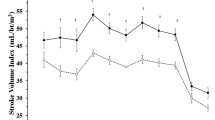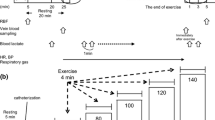Abstract
The present study examined the effect of age on the control of renal blood flow (RBF; PAH clearance) and renal vascular conductance (RVC=RBF/mean arterial pressure) during and after a bout of dynamic exercise in a warm environment. Six healthy fit older men (O; 67± 1 years) and 6 young men (Y; 24± 2 years) were matched for body size, adiposity, and maximal oxygen uptake (VO2max). Subjects exercised at ∼50% of V02max for 90 minutes in an environment of 30°C, 60% humidity on each of 4 consecutive days, with data collected on days 1 and 4. There was no effect of repeated days of exercise on RBF or RVC, despite a 4% expansion of blood volume in Y (<l°/o in O). On each day, resting RBF was significantly lower in O (e.g., Y=1127± 67, O=852± 114 mL/min on day 1; p<0.05). During exercise, Y decreased RBF to a significantly (p<0.05) greater extent [− 508 (− 45%) and − 365 (− 36%) mL/min on days 1 and 4, respectively] than the O [− 98 (− 12%) and − 83 (− 12%) mL/min]. RVC followed a similar pattern, decreasing by 52% and 37% during exercise for Y vs only 15% and 13% for O. The relationships between ARBF and HR and ΔRBF and plasma norepinephrine concentration were independent of age, implying similar sympathetic control during exercise. During recovery, RBF and RVC increased as expected in Y, but continued to decrease in O, falling significantly below exercise values (p<0.05). Compared to young men, fit healthy older men redistribute less blood flow away from the kidneys during dynamic exercise in the heat, an effect which appears to result from the existence of a smaller resting RBF rather than differential sympathetic control. On the other hand, chronological age seems to be associated with altered control of RBF and RVC during recovery from exercise. (Aging Clin. Exp. Res. 6: 293–302, 1994)
Similar content being viewed by others
References
Rowell L.B.: Cardiovascular adjustments to exercise and thermal stress. Physiol. Rev. 54: 75–159, 1974.
Rowell L.B., Blackmon J.R., Martin R.H., Mazzerella J.A., Bruce R.A.: Hepatic clearance of indocyanine green in man under thermal and exercise stresses. J. Appl. Physiol. 20: 384–394, 1965.
Barclay J.A., Cooke W.T., Kenney R.A., Nutt M.E.: The effects of water diuresis and exercise on the volume and composition of urine. Am. J. Physiol. 148: 327–337, 1947.
Radigan L.R., Robinson S.: Effects of environmental heat stress and exercise on renal blood flow and filtration rate. J. Appl. Physiol. 2: 185–191, 1949.
Smith J.H., Robinson S., Pearcy M.: Renal responses to exercise, heat, and dehydration. J. Appl. Physiol 4: 659–665, 1952.
Zambraski E. J.: Renal regulation of fluid homeostasis during exercise. In: Gisolfi C.V., Lamb D.R. (Eds.), Fluid Homeostasis During Exercise. Benchmark Press, Carmel, IN, 1990, pp. 247–280.
Castenfors J.: Renal function during prolonged exercise. Ann. NY Acad. Sci. 301: 151–159, 1977.
Grimby G.: Renal clearances during prolonged supine exercise at different loads. J. Appl. Physiol 20: 1294–1298, 1965.
Galbo H., Holst J.J., Christensen N.J.: Glucagon and plasma catecholamine responses to graded and prolonged exercise in man. J. Appl Physiol. 38: 70–76, 1975.
Tidgren D., Hjemdahl P., Theodorsson E., Nussberger J.: Renal neurohormonal and vascular responses to dynamic exercise in humans. J. Appl Physiol. 70: 2279–2286, 1991.
Rowell L.B.: Human Cardiovascular Control. Oxford University Press, New York, 1993.
Rowell L.B., Brengelmann G.L., Freund P.R.: Unaltered norepinephrine: heart rate relationship with exogenous heat. J. Appl Physiol. 62: 646–650, 1987.
Davies D.F., Shock N.W.. Age changes in glomerular filtration rate, effective renal plasma flow and tubular excretory capacity in adult males. J. Clin. Invest 29: 496–507, 1950.
Watkin D.M., Shock N.W.: Agewise standards for CIN, CPAH, and TmPAH in adult males. J. Clin. Invest. 34: 969, 1955.
Convertino V.A., Brock P.J., Keil L.C., Bernauer E.M., Greenleaf J.E.: Exercise training-induced hypervolemia: role of plasma albumin, renin, and vaso-pressin. J. Appl. Physiol 48: 665–669, 1980.
Green H.J., Jones L.L., Hughson R.L., Painter D.C., Farrance B.W.: Training-induced hypervolemia: lack of an effect on oxygen utilization during exercise. Med. Sci. Sports Exerc. 19: 202–206, 1987.
Green H.J., Jones L.L., Painter D.C.: Effects of exercise induced hypervolemia on cardiac function during prolonged exercise. Med. Sci. Sports Exerc. 22: 488–493, 1990.
Henane R., Flandrois R., Charbonnier J.P.: Increases in sweating sensitivity by endurance conditioning in man. J. Appl Physiol 43: 822–828, 1977.
Pandolf K.B., Cadarette B.S., Sawka M.N., Young A.J., Francesconi R.P., Gonzalez R.R.: Thermoregulatory responses of middle-aged and young men during dry-heat acclimation. J. Appl. Physiol. 65: 65–71, 1988.
DuBois D., DuBois E.F.: Clinical calorimetry: a formula to estimate the appropriate surface area if height and weight be known. Arch. Intern. Med. 17: 863–871, 1916.
Allen T.H., Peng M.T., Chen K.P., Huang T.F., Chang C., Fang H.S.: Prediction of adiposity from skinfolds and the curvilinear relationship between external and internal adiposity. Metab. Clin. Exp. 5: 346–352, 1956.
Voorrips L.E., Ravelli A.C.J., Dongelmans P.C.A., Deurenberg P., Staveren W.A.V.: A physical activity questionnaire for the elderly. Med. Sci. Sports Exerc. 23: 974–979, 1991.
Consolazio C.F., Johnson R.E., Pecora L.J.: Body composition procedures. In: Physiological Measurements of Metabolic Functions in Man. McGraw-Hill Book Company, New York, 1963, pp. 265–276.
Greenleaf J.E., Convertino V.A., Mangseth G.R.: Plasma volume during stress in man: osmolality and red cell volume. J. Appl Physiol. 47: 1031–1038, 1979.
Dill D.B., Costill D.L.: Calculation of percentage changes in volume of blood, plasma, and red cell in dehydration. J. Appl Physiol 37: 247–248, 1974.
Chasis H., Redish J., Goldring W., Ranges H.A., Smith H.W.: The use of sodium p-aminohippurate for the functional evaluation of the human kidney. J. Clin. Invest. 24: 583–588, 1945.
Harvey R.B., Brothers A.J.: Renal extraction of para-amino hippurate and creatinine measured by continuous in vivo sampling of arterial and renal vein blood. Ann. NY Acad. Sci. 102: 46–54, 1962.
Brun C.: A rapid method for the determination of para-aminohippuric acid in kidney function tests. J. Lab. Clin. Med. 37: 955–958, 1951.
Myers B.D., Peterson C., Molina C., Tomlanovich S.J., Newton L.D., Nitkin R., Sandier H., Murad F.: Role of cardiac atria in human renal response to changing plasma volume. Am. J. Physiol 254: F562–F573, 1988.
van Beaumont W.: Red cell volume with changes in plasma osmolality during maximal exercise. J. Appl Physiol 35: 47–50, 1973.
van Beaumont W., Greenleaf J.E., Juhos L.: Disproportionate changes in hematocrit, plasma volume, and proteins during exercise and bed rest. J. Appl. Physiol 33: 55–61, 1972.
Keeler R.: The effects of “dead space” and urine flow changes on the measurements of glomerular filtration rate by clearance methods. Can. J. Physiol. Pharm. 61: 435–438, 1983.
Castenfors J.: Renal function during exercise. Acta Physiol Scand. 70 (suppl. 293): 1–44, 1967.
Taverner D., Craig K., Mackay I., Watson M.L.: Effects of exercise on renal function in patients with moderate impairment of renal function compared to normal men. Nephron 57: 288–292, 1991.
Fleg J.L., Tzankoff S.P., Lakatta E.G.: Age-related augmentation of plasma catecholamines during dynamic exercise in healthy males. J. AppL Physiol. 59: 1033–1039, 1986.
Lehmann M., Keul J.: Age-associated changes of exercise-induced plasma catecholamine responses. Eur. J. AppL Physiol. 55: 302–306, 1986.
Sachs C., Hamberger B., Kaijser L.: Cardiovascular responses and plasma catecholamines in old age. Clin. Physiol. 5: 553–565, 1985.
Mazzeo R.S., Grantham P.A.: Sympathetic response to exercise in various tissues with advancing age. J. Appl. Physiol. 66: 1506–1508, 1989.
Kregel K.C.: Influence of aging on tissue-specific noradrenergic activity at rest and during nonexertional heat stress in rats. J. Appl. Physiol. 76: 1226–1231, 1994.
Kastello G.M., Sothmann M.S., Murthy V.S.: Young and old subjects matched for aerobic capacity have similar noradrenergic responses to exercise. J. Appl. Physiol. 74:49–54, 1993.
Hohimer A.R., Smith I.A.: Decreased renal blood flow in the baboon during mild dynamic leg exercise. Am. J. Physiol. 236: H141–H150, 1979.
Zambraski E.J., Tucker M.S., Lakas C.S., Grassl S.M., Scanes C.G.: Mechanism of renin release in the exercising dog. Am. J. Physiol. 246: E71–E76, 1984.
Chapman C.B., Henschel A., Minckler J., Forsgren A., Keys A.: The effect of exercise on renal plasma flow in normal male subjects. J. Clin. Invest. 27: 639–644, 1948.
Author information
Authors and Affiliations
Rights and permissions
About this article
Cite this article
Kenney, W.L., Zappe, D.H. Effect of age on renal blood flow during exercise. Aging Clin Exp Res 6, 293–302 (1994). https://doi.org/10.1007/BF03324255
Received:
Accepted:
Published:
Issue Date:
DOI: https://doi.org/10.1007/BF03324255




